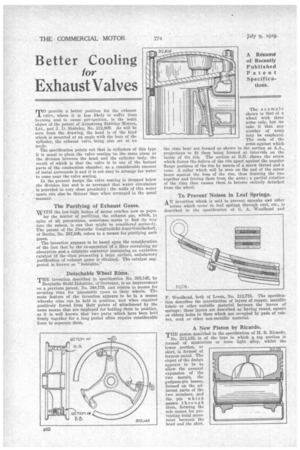Better Cooling
Page 120

If you've noticed an error in this article please click here to report it so we can fix it.
for
Exhaust Valves
T°provide a better position for the exhaust valve, where it is less likely to suffer from burning -and to cause pre-iguition, is the main object of the patent of Armstrong Siddeley Motors, Ltd., and J. D. Siddeley, No. 312,809. As will be seen from the drawing, the head is of the kind which is mounted at an angle with the bore of the cylinder, the exhaust valve being also set at an angle.
The specification points out that in cylinders of this type it is usual to place the valve seating Yon the same plane as the division between the -head and the cylinder body, the result of which is that the valve is in one of the hottest parts of the combustion chamber, as a considerable amount of metal surrounds it and it is not easy to arrange for water to come near the valve seating.
In the present design the valve seating is dropped below the division line and is so arranged that water circulation is provided in very close proximity ; the walls of this water space can also be thinner than when arranged in the usual manner.
The Purifying of Exhaust Gases.
WITH the low-built bodies of motor coaches now so popu lar the matter of purifying the exhaust gas, which, in spite of all precautions, sometimes seems to find its way into the saloon, is one that might be considered seriously. The patent of the Deutsche Gasgliinlicht-Auer-Gesellsehaft, of Berlin, No. 287,106, refers to a means for purifying such gases.
The invention appears to be based upon the consideration of the fact that by the co-operation of a-filter containing an absorptive-and a catalytic converter containing an oxidation catalyst of the class presenting a large surface, satisfactory purification of exhaust gases is obtained. The catalyst suggested is known as " honealite."
Detachable Wheel Riins.
THE invention described in specification No. 303,145, by Bergische Stahl-Industrie, of Germany, is an improvement on a previous patent, No. 249,779, and relates to means for securing rims for pneumatic tyres to their wheels. The main feature of the invention appears to be in a means whereby rims can be held in position, and when required positively forced from their points of attachment by the same means that are employed for holding them in position, as it is well known that two parts which have been held firmly together for a long period often require considerable force to separate them.
The example shown is that of a wheel with three arms only, but we take it that any number of arms may be employed. The ends of the arms against which the rims bear are formed as shown in the section at AA., projections to fit them being formed at intervals on the inside of the rim. The sectien at B.B. shows the screw which forces the halves of the rim apart against the angular flange portions of the rim by means of a serew thread and a cone. A collar which will be seen on the end of the screw bears against the boss of the rim, thus drawing the two together and freeing them from the arms; a partial rotation of the rims then causes them to become entirely detached from the wheel.
To Prevent Noises in Leaf Springs.,
AN invention which is said to prevent squeaks and other noises which occur in leaf springs through rust, etc., is described in the specification of G. A. Woodhead and F. Woodhead, both of Leeds, No. 312,778. The specification describes the introduction of layers of copper, metallic fabric or other suitable material between the leaves of springs; these layers are described as having round, square or oblong holes in them which are occupied by pads of rubber, cork or other non-metallic material.
A New Piston by Ricardo.
THE piston described in the specification of H. R. Ricardo, No. 312,133, is of the type in which a top portion is formed of aluminium or some light alloy, whilst the lower portion, or skirt, is formed of ferrous metal. The object of the design appears to be to allow the unequal expansion of the two metals, the gudgeon-pin bosses, formed on the adjacent parts of the two members, and the pin which passes through them, forming the sole means for preventing axial movement between the head and the skirt.
















































































































































































